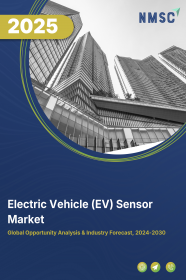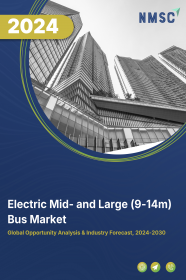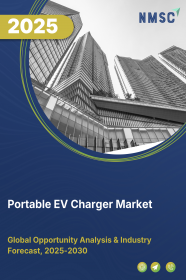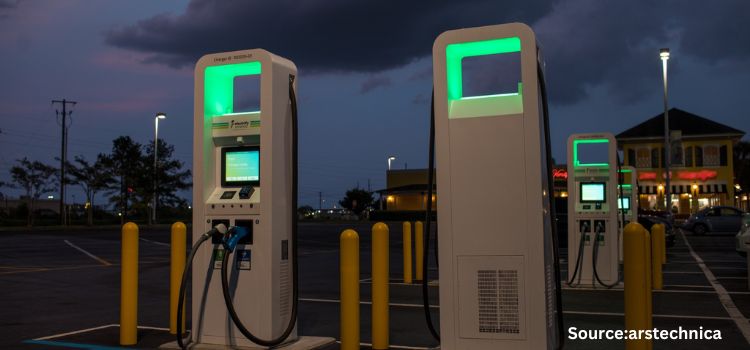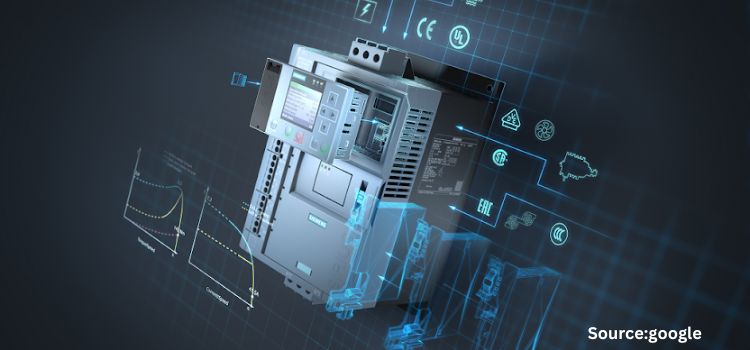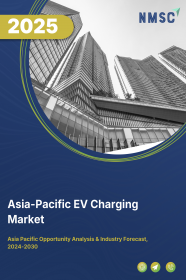
Asia-Pacific Electric Vehicle (EV) Charging Market by Charging Type (Off-Board Top-Down Pantograph, On-Board Bottom-Up Pantograph, and Charging Via Connector), Charging Voltage Level (Level 1 (<3.7 KW), Level 2 (3.7–22 KW), and Level 3 (Above 22 KW)), Charger Type (Slow Charger and Fast Charger), Vehicle Charging (AC, DC, Inductive Charging) and Others– Opportunity Analysis and Industry Forecast 2023–2030
Industry: Automotive & Transportation | Publish Date: 15-Feb-2025 | No of Pages: 318 | No. of Tables: 266 | No. of Figures: 235 | Format: PDF | Report Code : AT867
US Tariff Impact on Asia-Pacific EV Charging Market
Trump Tariffs Are Reshaping Global Business
Market Definition
Asia-Pacific Electric Vehicle (EV) Charging Market was valued at USD 11.82 billion in 2022, and is predicted to reach USD 81.37 billion by 2030, with a CAGR of 28.0% from 2023 to 2030. Electric vehicle chargers are characterized by the rate at which they deliver energy to the vehicle's battery. They serve as a vital infrastructure connecting plug-in electric vehicles to electrical outlets for the purpose of recharging the vehicle's battery. These chargers facilitate the charging process by supplying the necessary electrical energy to the EV's battery.
Charging stations are compatible with electric vehicles, neighborhood electric vehicles (NEVs), and plug-in hybrids, allowing them to connect to an electrical source for charging. Some charging stations come equipped with advanced functionalities such as smart meters, cellular connectivity, and network access.
The charging of EVs can be carried out through several levels of charging such as level 1, level 2, and level 3. The higher the level of charging, the faster the charging process causing more power to be delivered to the vehicle. The use of electric vehicles significantly reduces the carbon footprints released into the atmosphere, which contain toxic gas. The growing threat of carbon emissions and other harmful gases stemming from transportation has triggered the vital necessity of adopting electric vehicles.
In addition, the penetration of EV charging is high in commercial spaces as compared to residential ones. Long-distance trips would benefit from ultra-fast charging capabilities made possible by public charging infrastructure. However, EV chargers for residential spaces offer significant growth potential as they are affordable and more convenient for charging electric vehicles as compared to commercial charging stations.
Government Incentives and Policies Driving Electric Vehicle Adoption in the Asia-Pacific Region
The Asia-Pacific region, comprising countries such as Asia-Pacific, Japan, India, Australia, South Korea, Thailand, Singapore, and more, is witnessing substantial growth in the EV charging market. This growth is primarily driven by proactive government initiatives aimed at accelerating the adoption of electric vehicles and the development of supporting infrastructure. These initiatives often include various incentives, such as subsidies, tax benefits, and regulatory measures, all aimed at reducing emissions and promoting cleaner transportation solutions.
Simultaneously, the increasing demand for fast-charging infrastructure plays a pivotal role in driving market growth. Fast-charging addresses the need for convenient and efficient charging options, further boosting the expansion of the EV charging market throughout the region.
Shared Mobility Operators' EV Deployments and Expanding Manufacturing Boosting Asia-Pacific EV Charging Market Growth
The Asia-Pacific electric vehicle (EV) charging market is undergoing substantial growth due to two main factors. Firstly, shared mobility operators, including ride-sharing and car-sharing companies, are increasingly adopting EVs in their fleets due to environmental concerns and cost-effectiveness. Secondly, the region is experiencing a surge in EV manufacturing, with both established automakers and startups expanding their production capabilities.
This boost in EV manufacturing not only increases the availability of electric vehicles but also creates a greater demand for an extensive and accessible charging infrastructure network. These two factors work in synergy, driving the growth of the EV charging market throughout the Asia-Pacific region.
Fast Chargers' High Initial Setup Costs Hinder the EV Charging Market Growth
The growth of the EV charging sector may face challenges due to the absence of incentives and concerns over high installation costs. A significant barrier to expanding this industry is the substantial upfront expense associated with level 3 and ultra-fast chargers. While level 1 and level 2 chargers can take anywhere from 6 to 16 hours for a full charge, consumers are used to refueling their traditional fossil fuel vehicles in just 5 to 7 minutes.
This has created a strong market demand for fast chargers capable of recharging EVs in under 30 minutes. However, the initial costs for level 3 charging stations might discourage those considering the switch to EVs, especially owing to the longer charging times could disrupt their already busy schedules.
Surging Adoption of Vehicle-to-Grid (V2G) EV Charging Stations in Asia-Pacific Unlocks Promising Opportunities
A technology called vehicle-to-grid (V2G) EV charging allows plug-in EVs and the power grid to exchange electrical energy in both directions. Electric vehicles (EVs) can store extra electricity and release it to the grid thanks to V2G technology. This may enhance the functionality of the electrical component and increase value for EV owners.
The development of this concept has made charging for electric vehicles easier, and EVs are now among people's top transportation options. As a result, the entire market for charging stations is essential for connecting the electric vehicle to the grid and enabling the vehicle to charge.
Two V2G EV vehicle charging stations were erected by Enel Energia S.p.A. at the Italian Institute of Technology's Genoa headquarters. The installation is a part of MOV-E, a Nissan-sponsored corporate electric car sharing trial project. The Italian Institute of Technology received two battery electric vehicles (LEAF models) from Nissan as well as the Glide app management platform. The partnership between Enel and Nissan represents a shift in the way that technology is used for sustainable transportation.
As a result, manufacturers have a great chance with the V2G charging technology because it is predicted to change the EV industry and determine how EVs will be charged in the future. Although V2G infrastructure is more beneficial than smart charging, installing V2G charging stations has a hefty up-front cost. Manufacturers of EV connectors are projected to have opportunities to produce sophisticated connectors to withstand electrical architecture due to the predictable and anticipated expansion of V2G technology.
Competitive Landscape
The Asia-Pacific Electric Vehicle (EV) Charging industry includes several market players such as ABB Ltd., ChargePoint, Inc, Tesla Inc, Shell Recharge Solutions, Star Charge, TELD, Siemens, BYD, EVgo, and Hyundai Motor Company.
Key Benefits
-
The Asia-Pacific Electric Vehicle (EV) Charging market report provides a quantitative analysis of the current market and estimations through 2023-2030 that assists in identifying the prevailing market opportunities to capitalize on.
-
The study comprises a deep dive analysis of the market trend including the current and future trends for depicting the prevalent investment pockets in the market.
-
The information related to key drivers, restraints, and opportunities and their impact on the market is provided in the report.
-
The competitive analysis of the market players along with their market share in the Asia-Pacific Electric Vehicle (EV) Charging market.
-
The SWOT analysis and Porter’s Five Forces model are elaborated in the study.
-
Value chain analysis in the market study provides a clear picture of the stakeholders’ roles.
Asia-Pacific Electric Vehicle (EV) Charging Market Key Segments
By Charging Type
-
Off-Board Top-Down Pantograph
-
On-Board Bottom-Up Pantograph
-
Charging Via Connector
By Charging Voltage Level
-
Level 1 (<3.7 KW)
-
Level 2 (3.7–22 KW)
-
Level 3 (Above 22 KW)
By Charger Type
-
Slow Charger
-
Fast Charger
By IOT Connectivity
-
Non-Connected Charging Stations
-
Smart Connected Charging Stations (Networked)
By Vehicle Charging
-
AC (Normal Charging)
-
DC (Super Charging)
-
Inductive Charging
By Application
-
Commercial
-
Residential
By Commercial
-
Commercial Public EV Charging Stations
-
On-Road Charging
-
Parking Spaces
-
Destination Chargers
-
-
Commercial Private EV Charging Stations
-
Fleet Charging
-
Captive Charging
-
By Installation Type
-
Portable Charging
-
Fixed Charging
-
Wall Mount
-
Pedestal Mount
-
Ceiling Mount
-
By Charging Standard
-
CCS
-
CHADEMO & GB/T
-
Type 1/Normal Charging
-
Tesla Super Charger
-
Type-2
-
Level 3
Key Players
-
ABB Ltd.
-
ChargePoint, Inc
-
Tesla Inc
-
Shell Recharge Solutions
-
Star Charge
-
TELD
-
Siemens
-
BYD
-
EVgo
-
Hyundai Motor Company
REPORT SCOPE AND SEGMENTATION:
|
Parameters |
Details |
|
Market Size in 2022 |
USD 11.82 Billion |
|
Market Volume in 2022 |
1255 Thousand Units |
|
Revenue Forecast in 2030 |
USD 81.37 Billion |
|
Growth Rate |
CAGR of 28.0% from 2023 to 2030 |
|
Analysis Period |
2022–2030 |
|
Base Year Considered |
2022 |
|
Forecast Period |
2023–2030 |
|
Market Size Estimation |
Billion (USD) |
|
Growth Factors |
The increasing government initiatives. The growing adoption of EVs by shared mobility operators. |
|
Countries Covered |
7 |
|
Companies Profiled |
10 |
|
Market Share |
Available for 10 companies |
|
Customization Scope |
Free customization (equivalent up to 80 working hours of analysts) after purchase. Addition or alteration to country, regional, and segment scope. |
|
Pricing and Purchase Options |
Avail customized purchase options to meet your exact research needs. |

















 Speak to Our Analyst
Speak to Our Analyst



